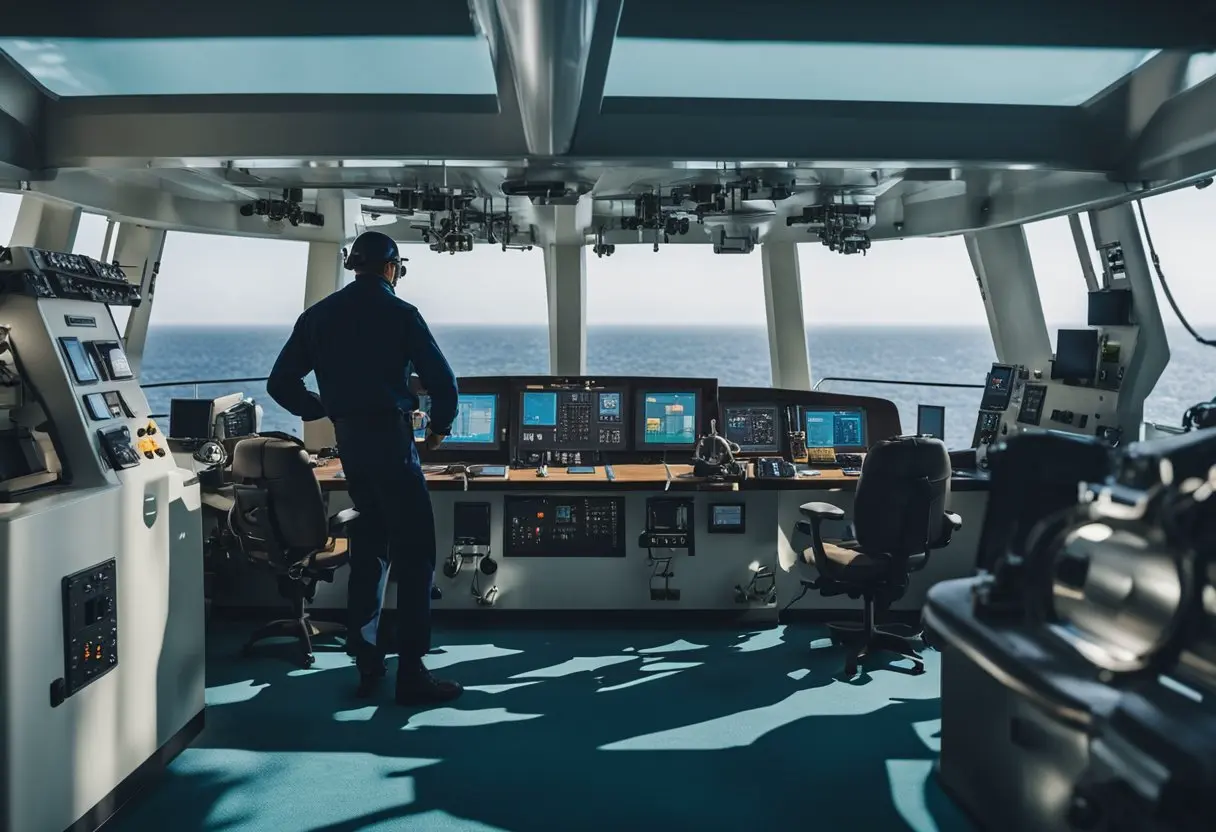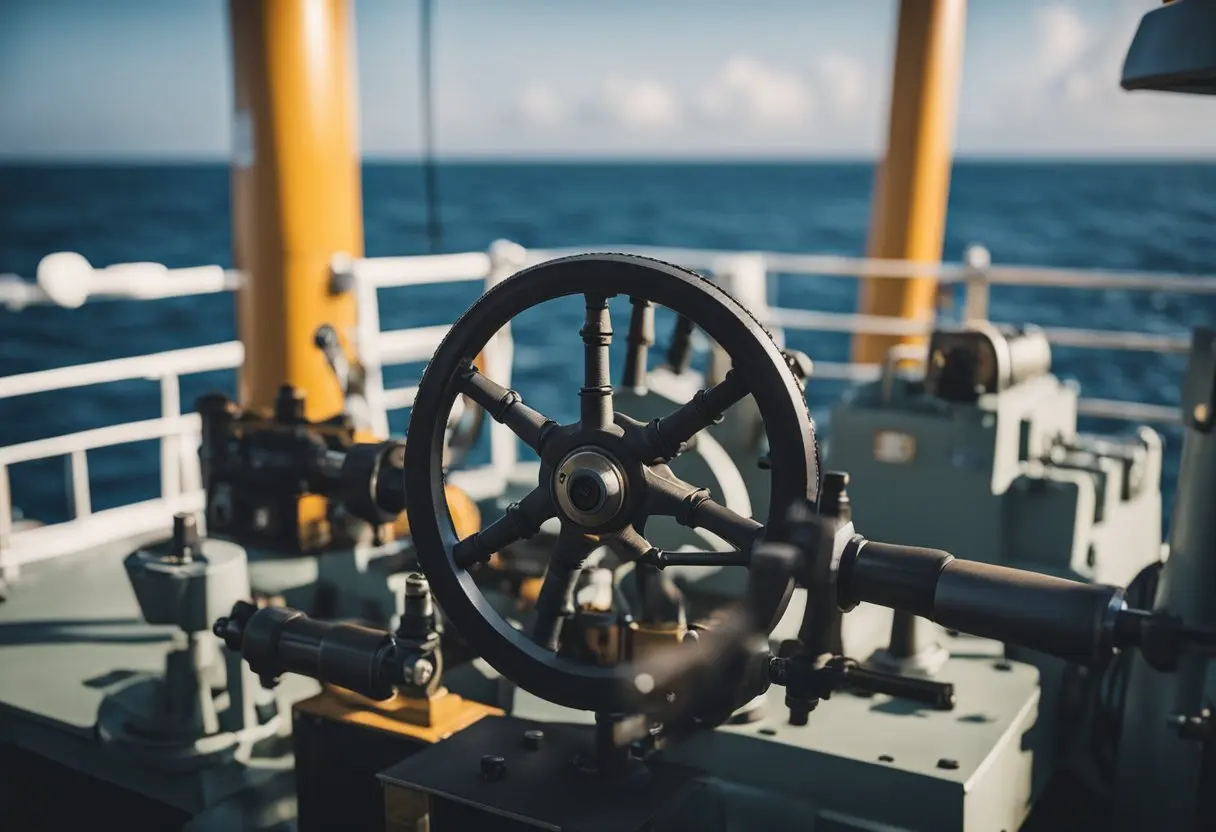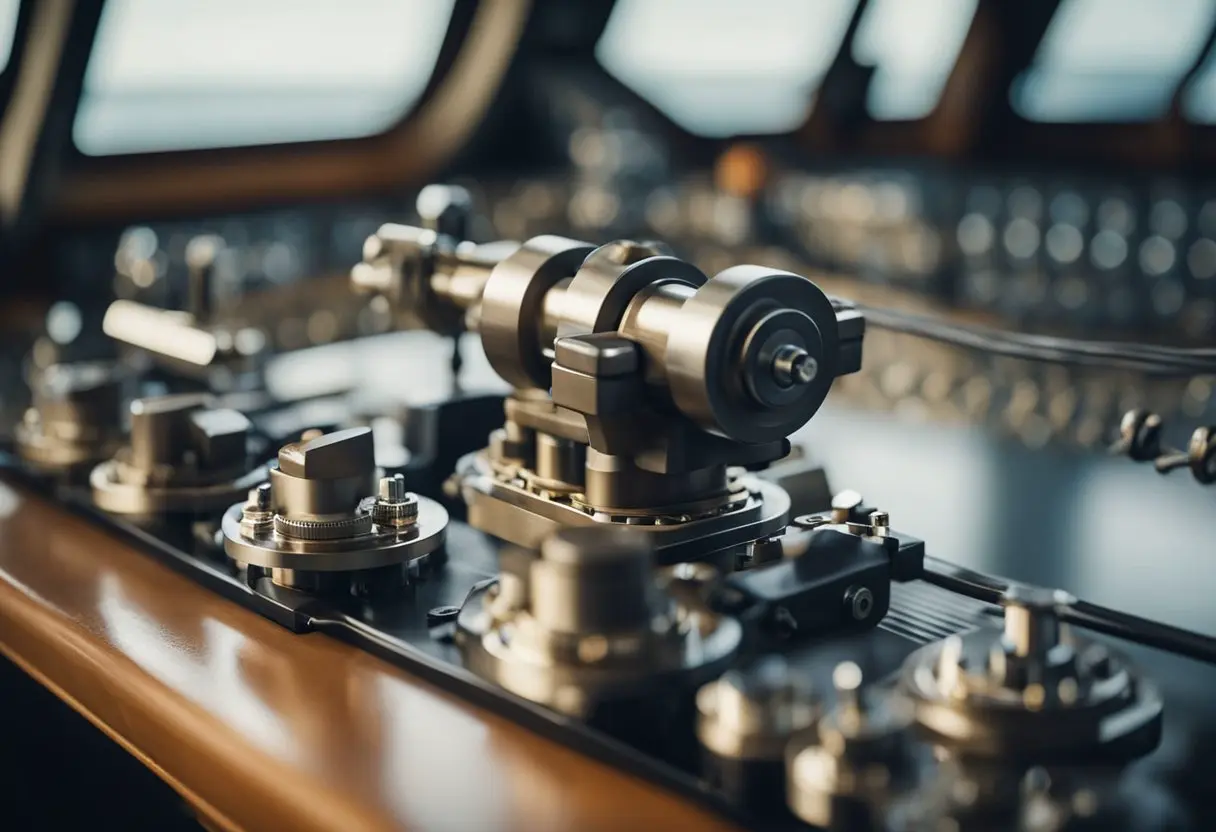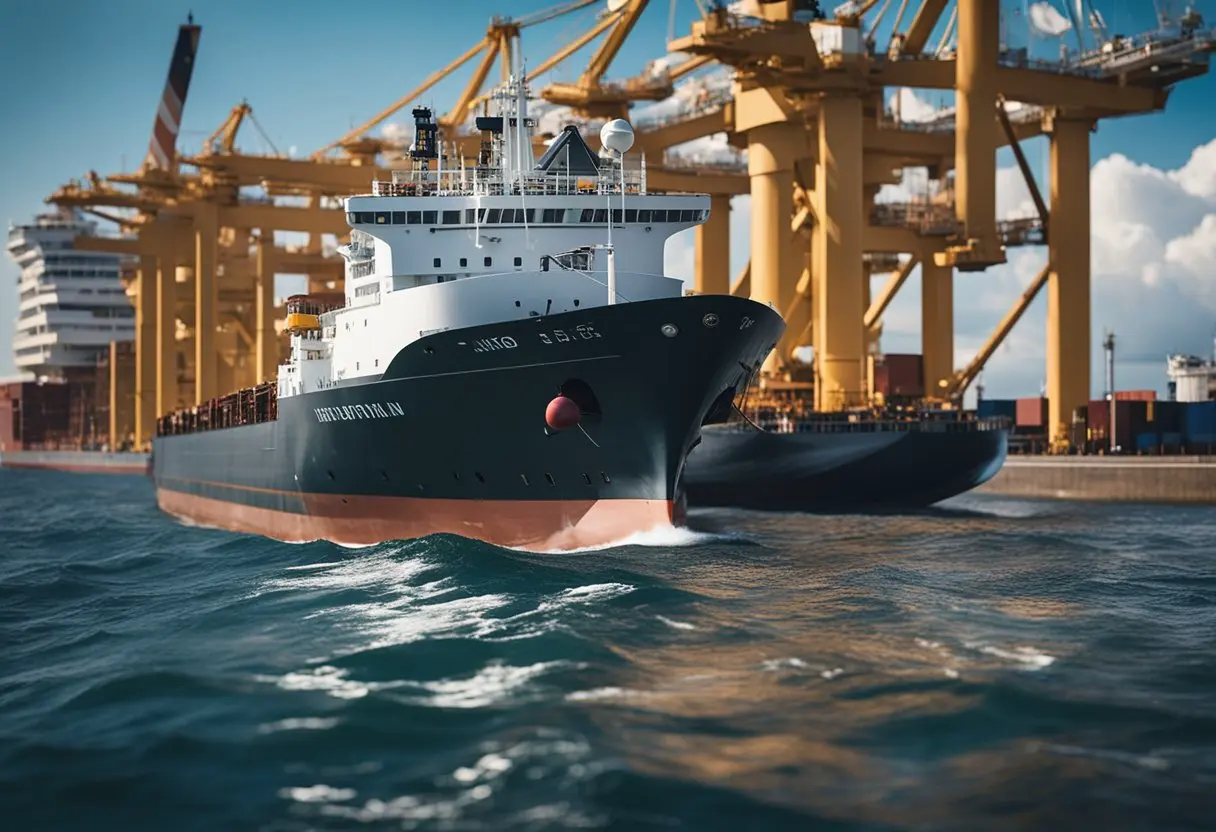Steering Gear in Ships: Cargo ships are massive vessels that transport goods across the world’s oceans. To navigate these behemoths, they require a complex system of machinery and equipment, including powerful engines, advanced navigation systems, and sophisticated steering gear. Steering gear is a crucial component of any ship, allowing it to turn and maneuver in the open sea.
The steering gear of a cargo ship consists of several key parts, including the rudder, steering wheel, and hydraulic systems. The rudder is a large, flat object that is attached to the stern of the ship and is used to steer the vessel. The steering wheel is located on the bridge of the ship and is used to turn the rudder. The hydraulic systems are responsible for transmitting the force from the steering wheel to the rudder, allowing the ship to turn in the desired direction.
Basics of Marine Steering Systems

Marine steering systems are crucial for the safe and efficient operation of cargo ships. These systems enable the ship to turn, change course, and maintain a steady heading. There are two main types of steering systems used in cargo ships: hydraulic and electric.
Components of Steering Gear
Regardless of the type of steering system, the basic components remain the same. The steering gear consists of a steering wheel, a rudder, and a system of gears, hydraulic cylinders, and motors that transfer the motion of the steering wheel to the rudder. The steering wheel is typically located on the bridge of the ship, and the rudder is located at the stern.
Hydraulic Systems in Steering
Hydraulic steering systems are the most common type of steering system used in cargo ships. In a hydraulic system, the motion of the steering wheel is transferred to a hydraulic pump, which pressurizes hydraulic fluid. The pressurized fluid is then used to move hydraulic cylinders, which in turn move the rudder.
Hydraulic systems are reliable and efficient, and they provide a high degree of control over the ship’s steering. However, they can be expensive to install and maintain.
Electric Systems in Steering
Electric steering systems use electric motors to move the rudder. In an electric system, the motion of the steering wheel is transferred to an electric motor, which then moves the rudder. Electric systems are less common than hydraulic systems, but they are becoming more popular due to their lower cost and ease of maintenance.
Electric systems are also more environmentally friendly than hydraulic systems, as they do not require hydraulic fluid. However, they may not provide the same level of control over the ship’s steering as hydraulic systems.
In conclusion, understanding the basics of marine steering systems is essential for anyone involved in the operation of cargo ships. Whether using hydraulic or electric systems, the steering gear is a critical component of the ship’s navigation system, and it must be maintained and operated with care and precision.
Operation of Steering Gear in Ships

The steering gear is an essential system on a cargo ship that helps to steer the vessel in the desired direction. It is operated by the ship’s crew through the bridge and engine room controls.
Bridge Control Operations
The bridge control operations are responsible for the steering of the ship during normal navigation. The steering gear is operated by the helmsman who is stationed at the helm position on the bridge. The helmsman uses the steering wheel to turn the rudder and change the ship’s direction. The rudder angle indicator on the bridge displays the angle of the rudder, which helps the helmsman to steer the ship in the desired direction.
In case of an emergency, the bridge control operations can be overridden by the emergency steering gear. The emergency steering gear is operated manually from the steering gear room.
Engine Room Steering Operations
The engine room steering operations are responsible for the steering of the ship during maneuvering. The maneuvering is carried out by the ship’s engineer who is stationed in the engine room. The engine room control panel displays the rudder angle and steering gear status. The engineer uses the control panel to turn the rudder and change the ship’s direction.
The steering gear system is designed to provide the necessary force to turn the rudder, which depends on the size and speed of the ship. The capacity of the steering gear system should be such that the rudder can be turned from 35 degrees port to 35 degrees starboard and vice versa, and it should be able to turn the rudder from 30 degrees on one side to 35 degrees on the other side within 28 seconds.
In conclusion, the operation of the steering gear is critical for the safe navigation of a cargo ship. The bridge control operations and engine room steering operations work together to ensure that the ship is steered in the desired direction.
Turning Mechanics
Cargo ships are massive vessels that require a lot of energy to turn. Steering gear systems are responsible for controlling the rudder and turning the ship. The steering gear system generates a torsional force that is transmitted to the rudder stock, which turns the rudder and changes the direction of the ship.
Rudder Dynamics
The rudder is a flat, vertical surface located at the stern of the ship. It is connected to the steering gear system and is responsible for turning the ship. The rudder’s effectiveness depends on its size, shape, and the speed of the ship. A larger rudder provides more turning force but also generates more drag and slows down the ship. Similarly, a faster ship requires a larger rudder to generate the same turning force.
Ship’s Turning Circle
The ship’s turning circle is the path it follows when turning. The turning circle is affected by the ship’s speed, rudder angle, and the water’s resistance. The ship’s turning circle can be calculated by using the turning circle diagram, which shows the ship’s path relative to its initial course. The turning circle diagram is a valuable tool for ship navigators as it helps them anticipate the ship’s path and avoid collisions.
Effect of Propeller on Turning
The propeller is responsible for generating the thrust that propels the ship forward. However, it also affects the ship’s turning ability. When the ship’s propeller is turning, it generates a rotational force that opposes the turning force generated by the rudder. This force is known as the propeller walk. The propeller walk causes the ship to turn in the opposite direction of the rudder. Ship navigators must take the propeller walk into account when maneuvering the ship to avoid collisions.
In summary, turning a cargo ship requires a lot of energy and careful planning. The steering gear system generates a torsional force that turns the rudder and changes the direction of the ship. The ship’s turning circle is affected by its speed, rudder angle, and the water’s resistance. The propeller generates a rotational force that opposes the turning force generated by the rudder, which must be taken into account when maneuvering the ship.
Steering Gear Safety and Maintenance in Ships

Cargo ships rely heavily on their steering gear to navigate through waterways and reach their destinations safely. Proper maintenance and safety procedures are crucial to ensure the steering gear operates efficiently and effectively. This section will cover regular inspection procedures, emergency steering procedures, and maintenance best practices.
Regular Inspection Procedures
Regular inspections of the steering gear are necessary to detect any potential issues before they become major problems. The following inspection procedures should be carried out regularly:
- Inspect the hydraulic system and check for any leaks, pressure drops, or abnormal noises in the system.
- Check the steering gear linkages and connections for any signs of wear or damage.
- Inspect the rudder and rudder stock for any signs of damage or corrosion.
- Test the steering gear to ensure it is functioning properly.
Emergency Steering Procedures
In the event of a steering gear failure, emergency steering procedures must be implemented immediately. The following steps should be taken:
- Sound the alarm to alert the crew.
- Activate the emergency steering system.
- Notify the bridge and engine room.
- Reduce speed and alter course if necessary.
- Monitor the steering gear closely until the issue is resolved.
Maintenance Best Practices
Proper maintenance of the steering gear is essential to ensure it operates efficiently and effectively. The following best practices should be followed:
- Regularly inspect and maintain the hydraulic system, steering gear linkages, and rudder.
- Keep all steering gear components clean and free of debris.
- Use only approved spare parts and equipment.
- Follow the manufacturer’s recommended maintenance schedule.
- Train crew members on proper maintenance and safety procedures.
By following these regular inspection procedures, emergency steering procedures, and maintenance best practices, cargo ships can ensure their steering gear operates efficiently and effectively, thus ensuring safe navigation through waterways.
Regulations and Standards

Cargo ships are subject to various regulations and standards regarding their steering gear systems. These regulations and standards are put in place to ensure the safety of the vessel, crew, and cargo.
International Maritime Organization Guidelines
The International Maritime Organization (IMO) has issued guidelines for the design, construction, and testing of steering gear systems. These guidelines are contained in IMO Resolution A.415(XI) and are intended to ensure that steering gear systems are reliable and effective in all operating conditions.
According to the guidelines, steering gear systems must be capable of steering the ship from 35 degrees port to 35 degrees starboard and vice versa within a time frame of a maximum of 28 seconds. The guidelines also require that the steering gear system be able to operate at full power for at least 10 minutes and that it be capable of steering the vessel in case of failure of the main steering gear.
Classification Society Requirements
Classification societies such as Lloyd’s Register, DNV GL, and ABS have their own requirements for steering gear systems. These requirements are in addition to the regulations set forth by the IMO and are intended to ensure that the steering gear system meets the specific needs of the vessel.
For example, Lloyd’s Register requires that the steering gear system be designed to withstand the forces generated by the rudder and be capable of steering the vessel in all conditions, including heavy weather. DNV GL requires that the steering gear system be designed to withstand the maximum expected loads and that it be tested to ensure that it meets these requirements.
In addition to these requirements, classification societies also require that the steering gear system be inspected and tested periodically to ensure that it remains in good working order. These inspections and tests are typically carried out during the vessel’s annual survey and are intended to identify any potential problems with the steering gear system before they become a safety issue.
Technological Advancements in Steering Gear
With the advancement of technology, steering gear systems in cargo ships have undergone significant changes. These changes have improved the safety, efficiency, and reliability of steering gear mechanisms. Two of the most significant technological advancements in steering gear systems are Integrated Navigation Systems and Automation in Steering Mechanisms.
Integrated Navigation Systems
Integrated Navigation Systems (INS) are a combination of various navigational equipment and sensors that work together to provide accurate and reliable information to the crew. INS can integrate with the steering gear system to provide real-time information to the crew about the ship’s position, speed, and direction. This information can be used to make informed decisions about the steering of the ship, ensuring the safety of the crew and cargo.
Automation in Steering Mechanisms
Automation in steering mechanisms has revolutionized the way cargo ships are steered. Automated steering mechanisms use sensors and computer systems to control the rudder and keep the ship on course. These systems can adjust the rudder angle automatically, based on the ship’s speed, direction, and sea conditions. This automation has significantly reduced the workload of the crew and improved the efficiency of the steering gear system.
In addition to these advancements, modern steering gear systems are also designed to be more reliable and durable. Hydraulic systems have replaced mechanical systems, and electronic controls have replaced manual controls. These changes have made steering gear systems more efficient, safer, and easier to operate.
Overall, these technological advancements in steering gear systems have improved the safety, reliability, and efficiency of cargo ships. The integration of navigation systems and automation in steering mechanisms has made it easier for the crew to operate the steering gear system, reducing the workload and improving the accuracy of the steering.
FAQs About Steering Gear in Ships
What are the main components of a ship’s steering gear system?
A ship’s steering gear system consists of several components, including the steering wheel, rudder, hydraulic power unit, and control valve. The steering wheel is used to control the direction of the vessel, while the rudder is responsible for changing the direction of the ship. The hydraulic power unit provides the necessary power to move the rudder, while the control valve regulates the flow of hydraulic fluid to the rudder.
Can you explain the function of a rotary vane steering gear on a cargo ship?
The rotary vane steering gear is a type of hydraulic-powered transmission unit used on cargo ships. It consists of a fixed housing and a rotating vane that is connected to the rudder. When hydraulic fluid is pumped into the housing, the vane rotates, which in turn moves the rudder and changes the direction of the ship.
What is the role of a ram-type steering gear in maneuvering a vessel?
The ram-type steering gear is another type of hydraulic-powered transmission unit used on cargo ships. It consists of two or four hydraulic cylinders that are connected to the rudder. When hydraulic fluid is pumped into the cylinders, they extend or retract, which in turn moves the rudder and changes the direction of the ship.
How does the steering wheel on a ship control its direction?
The steering wheel on a ship is connected to the control valve of the steering gear system. When the wheel is turned, it operates the control valve, which regulates the flow of hydraulic fluid to the rudder. By controlling the flow of hydraulic fluid, the steering gear system can change the direction of the rudder and the ship.
What is the process involved in turning a large cargo ship?
Turning a large cargo ship involves a complex process that requires careful planning and coordination. The captain must first determine the desired course and direction of the ship. Then, the steering gear system is used to turn the rudder and change the direction of the ship. The engine is also used to control the speed and momentum of the vessel during the turn.
Related Posts:
